Technology for outdoor power equipment is continuously advancing and every new leaf blower seems to have more power than the last. But how do you know if you have enough leaf blower power for you? Or, how do you know if a leaf blower has too much power? To know this you need to understand the main components of measuring leaf blower power, which are CFM and MPH.
Today, we are breaking down these components for measuring leaf blower power and helping you gauge the correct power level for you.
Leaf Blower Power Guide
- How to Measure Leaf Blower Power
- What is CFM?
- Gas vs Electric
- How Much Power Do I Need?
- TIA’s Top Leaf Blowers
- Wrap-up
How is Leaf Blower Power Measured?
Leaf blower power is based upon two main measurements: CFM and MPH. The power level also relies on the leaf blower’s overall voltage and power source. Let’s break each of these components down to understand them individually, as well as how each component impacts each other.
What is CFM?
CFM stands for cubic-feet-per-minute and this measurement refers to the amount of air moved in one minute and CFM is measured with an anemometer. Fans and air compressors also use this measurement, but for leaf blowers this measurement refers to the amount of air being pulled in and exiting through the blower over the course of a minute.
To put it simply, the higher the CFM, the more leaves and debris that can be moved in one minute, theoretically…
MPH
Miles-per-hour (MPH) is the other measurement used to calculate leaf blower power. This is a straightforward measurement that most people are used to. For leaf blowers it refers to the rate of speed at which air exits the blower.
One would assume a high CFM would create a high MPH. CFM definitely impacts MPH. However, MPH can be manipulated based on how wide or narrow the tube or nozzle is.
The Husqvarna Leaf Blaster™ Blower we recently reviewed is a great example of this. The high-speed nozzle is narrower, and that tighter concentration of air increases the MPH.
With that in mind, high CFM does not necessarily equate to high MPH. Buyers need to pay attention to both units of measurement.
Power Source
Gas and electric are the two main power sources for leaf blowers. Now, these two power sources are measured differently. Gas is measured in cc’s and electric is measured in voltage, and both play a significant role in the engine’s power and the resulting CFM and MPH.
Gas vs Electric
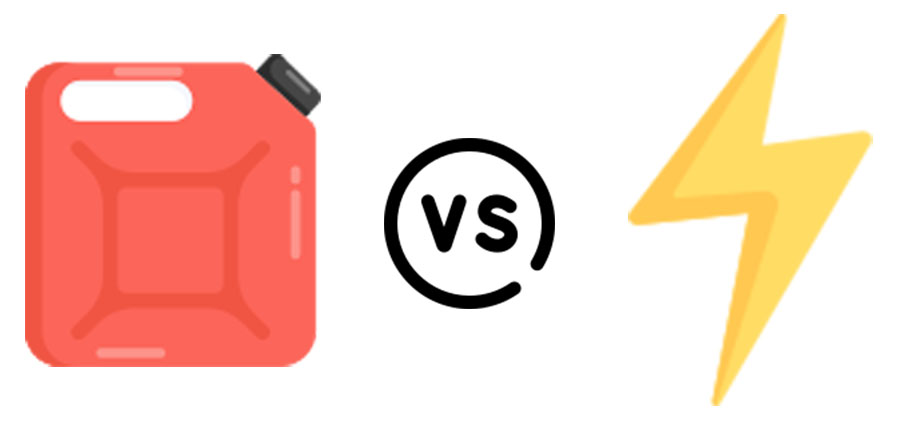
Power source is another important factor when determining a leaf blower’s power.
Over the years there has been a steady rise in electric leaf blowers and outdoor power equipment (OPE). However, many consumers still use gas-powered blowers. Both sides make claims about which is better. To me, neither is better, but they’re different.
Here are a few quick facts about each type of power source so you can decide which is best for you.
Gas
- Generally more affordable/lower upfront cost.
- Added expense of gas and oil.
- Requires regular maintenance.
- Arguably longer or higher power performance than most battery equivalents, plus quick and easy refueling.
- Loud when in use.
- Two-stroke fuel-burning is a known pollutant and carcinogen.
Electric
- Choice of corded or electric.
- Generally more expensive/higher upfront cost.
- Has renewable power source.
- Requires minimal maintenance.
- Shorter runtimes for battery-powered and may need multiple batteries to complete one area. However, battery recharge times are improving.
- Generally quieter than gas-powered leaf blowers.
- Arguably more environmentally friendly.
Based on current OPE battery technology, most homeowners can have their lawn and garden needs met with electric-powered leaf blowers and OPE.
How Much Leaf Blower Power Do I Need?
How much power you need will depend on what you need a blower for. Before purchasing, ask yourself:
- Is this leaf blower for personal or commercial use?
- How big is the area that I will regularly use this for?
- How often will I use this leaf blower?
- What is my budget?
- Do I want a gas or electric leaf blower?
A shopper with a small yard who only needs a blower for weekly maintenance obviously needs less power than someone with a large yard with lots of trees or multiple areas to maintain. Once you figure out where your needs fall you can then gauge the appropriate level of CFM for your needs.
Here is quick almost cheat sheet for knowing how much power the average person needs in these common settings.
- 200-400 CFM: Great for homeowners with average-sized yards. This power level can be found in 18-24V leaf blowers.
- 400-600 CFM: Perfect for people with larger lots such as homesteaders, landowners, and property managers. This power level can be found in 40V leaf blowers.
- 600-800 CFM: Ideal for landscapers or property owners with a lot of brush. This power level can be found in 40-80V leaf blowers.
Types of Leaf Blowers
There are three main types of leaf blowers: handheld, backpack, and walk-behind.
Handheld leaf blowers are the most common type of leaf blower, especially among everyday consumers since the price and performance meet the needs of the average homeowner. Backpack and walk-behind leaf blowers are more common in commercial settings, or those with large and/or multiple properties to manage.
Check out this video by Billy Goat Leaf Blowers to compare the performance of handheld, backpack, and walk-behind leaf blowers.
TIA’s Top Leaf Blowers
Are you ready to buy a leaf blower now that you’ve learned all that you can about leaf blower power? If so, we have good news for you. We have put together a quick list of our top leaf blowers for a variety of situations.
Warning: we love EGO OPE.
Best Blower for Homeowners: EGO Power+ 530 CFM
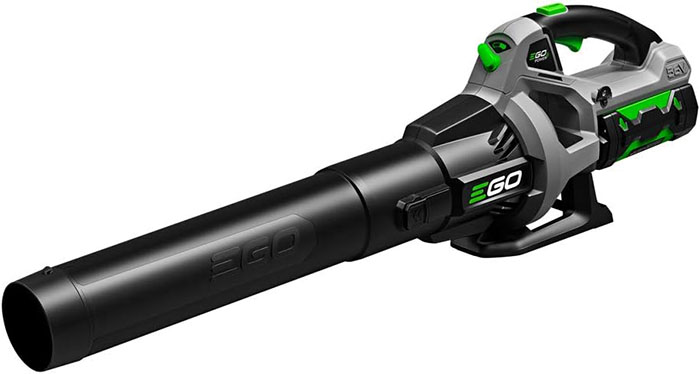
- Model Name: EGO Power+ 530 CFM Blower
- Model #: LB5302
- Great For: Homeowners with average to large size yards.
- Price: $199 with battery & charger.
- Amazon Review: “The blower packs a lot of power. I was pleasantly surprised. It by far exceeds the power of my last 3 corded blowers and is quieter than those plug-ins!” – RePete
- Where to Buy: EGO Leaf Blowers on Amazon
Best Budget Buy: RYOBI ONE+ Blower/Sweeper
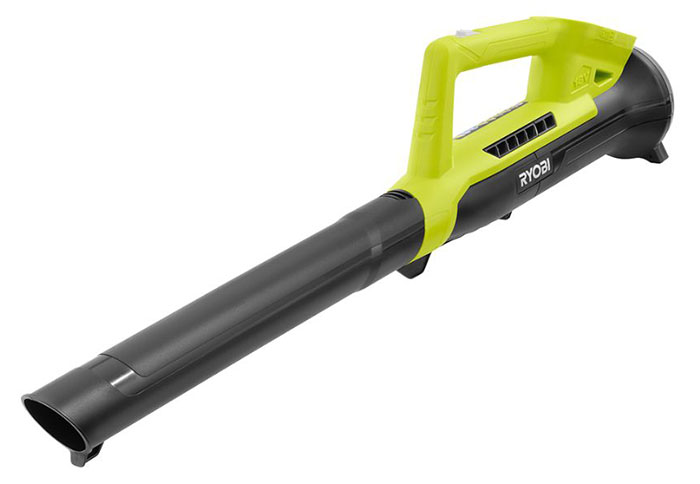
- Model Name: RYOBI ONE+ 18V 200 CFM Leaf Blower/Sweeper
- Model #: P2109BTLVNM
- Great For: Residents with small yards or patio clean-up, campers, and for clearing small and light debris.
- Price: $99 for bare-tool, $119 for tool, battery & charger.
- Home Depot Review: “This leaf blower has saved my back from raking up the leaves before I purchased this product. It’s so lightweight and can blow the leaves out of your yard effortlessly.” – andyreesecup
- Where to Buy: The Home Depot
Premium Pick: EGO Power+ 765 CFM
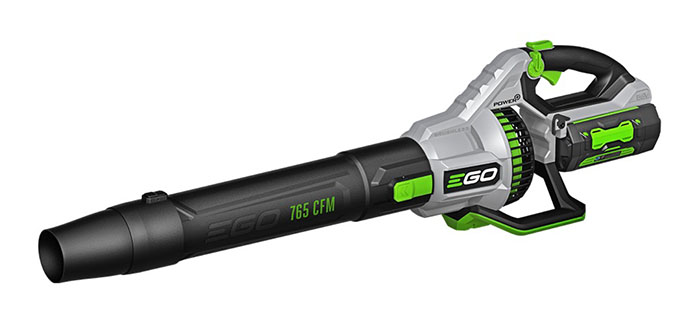
- Model Name: EGO Power+ 765 CFM Blower
- Model #: LB7654
- Great For: Consumers who need professional performance in an affordable consumer blower. Turbo Mode provides up to 765 CFM for some of the highest power in the industry, plus a 90-minute runtime.
- Price: $329 on sale for $299.
- Amazon Review: “It’s exceeded my expectations for its power and convenience. It charges fast and moves an impressive amount of air. I’ve easily cut the time to clean off walks, driveways, patios etc. in half” – Eric D
- Where to Buy: Amazon
Best Backpack Blower: EGO
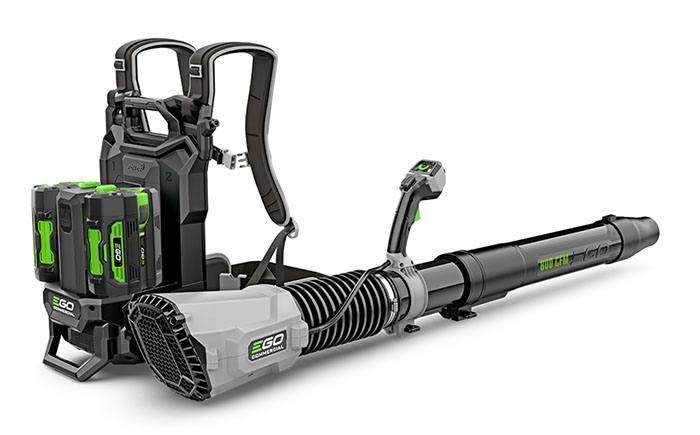
- Model Name: Commercial 800 CFM Backpack Blower with PeakPower™
- Model #: LBPX8000
- Great For: Professional landscapers or landowners with heavy brush.
- Price: $699 at most retailers. More budget-friendly models range between $269 to $529 on Amazon.
- Review: Read our TIA Review
- Where to Buy: View EGO site
Best Walk Behind Blower: Champion 1,300 CFM Gas Blower
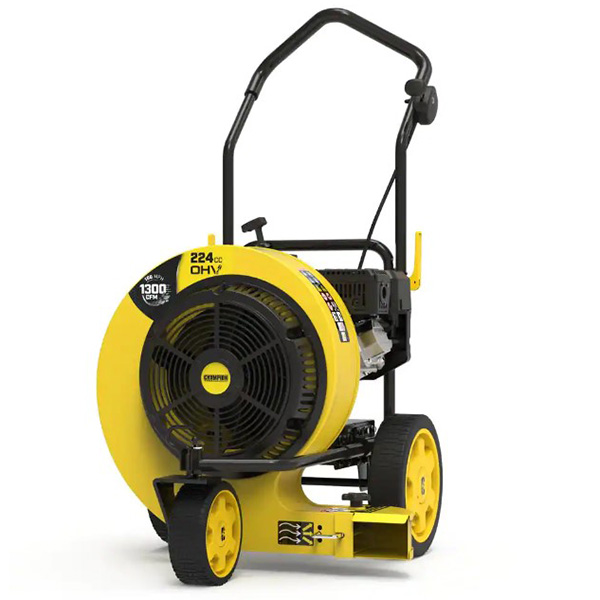
- Model Name: Champion Power Equipment 1,300 CFM 160 MPH 224 cc Walk-Behind Gas Leaf Blower with Swivel Front Wheel and 90-Degree Flow Diverter
- Model #: 200947
- Great For: Moving thick layers of leaves and debris quickly and efficiently.
- Price: $599
- Home Depot Review: “I bought this yesterday and set it up in about 30 minutes. Easy instructions and fast assembly. I added the provided oil and then gas. It started on the first pull. I cleared my backyard in about 45 minutes, which would have taken me two hours with my backpack blower. Easy to maneuver and did the job perfectly. I highly recommend this product.” – Ed J
- Where to Buy: The Home Depot
Final Thoughts on Leaf Blower Power
Buying your first leaf blower can be intimidating if you’ve never dealt with CFM’s or don’t know the difference between a volt and a cc. However, if you just sit down and take a moment to understand what these measurements mean it turns out it’s really not that complicated.
I hope you learned something today and are one step closer to finding the leaf blower that works for your life.

